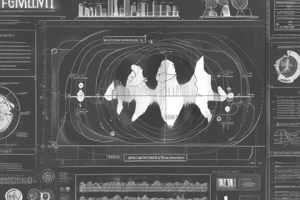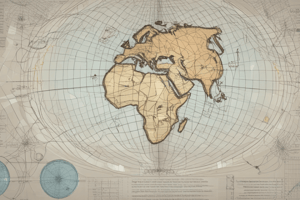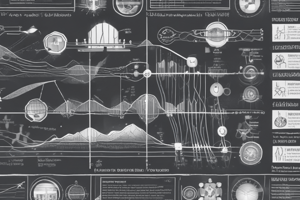Podcast
Questions and Answers
What is the independent variable in the researcher's experiment?
What is the independent variable in the researcher's experiment?
Genders
What is the dependent variable in the researcher's experiment?
What is the dependent variable in the researcher's experiment?
Neural responses
What is the difference between numerical data and categorical data?
What is the difference between numerical data and categorical data?
Numerical data is in the form of numbers, while categorical data is non-numeric
What type of graph would be most useful for comparing percentages?
What type of graph would be most useful for comparing percentages?
What does each slice of a pie chart represent?
What does each slice of a pie chart represent?
What does the height of a bar in a bar graph represent?
What does the height of a bar in a bar graph represent?
In the given example, which city has a greater average age, Chicago or New York?
In the given example, which city has a greater average age, Chicago or New York?
What is the purpose of formulating a hypothesis in a scientific experiment?
What is the purpose of formulating a hypothesis in a scientific experiment?
What are the basics of a scientific experiment?
What are the basics of a scientific experiment?
What is an independent variable and a dependent variable in an experiment?
What is an independent variable and a dependent variable in an experiment?
Flashcards are hidden until you start studying
Study Notes
Understanding Scientific Experiments
- Scientific experiments involve making observations, formulating a hypothesis, designing and conducting an experiment, collecting and evaluating data, and accepting or rejecting the hypothesis.
- The basics of a scientific experiment are:
- Making observations
- Formulating a hypothesis
- Designing and conducting an experiment
- Collecting and evaluating data
- Accepting or rejecting the hypothesis
- Formulating a new hypothesis if necessary
Variables in Experiments
- Independent variable (x): the cause, what is being manipulated to test a hypothesis
- Dependent variable (y): the effect, what is being influenced by the independent variable
- Examples of variables:
- Numerical data: numbers
- Categorical data: non-numerical values (e.g. country names)
Creating and Reading Graphs for Experiments
- Line graphs and tables are used to record independent and dependent variables and observe trends
- Tables list x and y values next to each other separately
- Line graphs chart x and y values as data points (x, y) on a graph
- Line graphs are used to compare numerical data and create a visual of trends
Interpreting Graphs and Charts
- Different types of data require different graphs and charts
- The way information is understood from these charts and graphs varies
- Types of graphs and charts include:
- Line graphs
- Bar charts
- Pie charts
- Flow charts
Line Graphs
- Plot independent (x) and dependent (y) variables on a graph to create a visual trend
- The graph contains an x-axis and a y-axis
- The x-axis is the horizontal axis, and the y-axis is the vertical axis
- Variables are represented as "coordinate pairs" (x, y)
- Line graphs are used when comparing strictly numerical data and are helpful when comparing small changes in a trend over time
Bar Charts
- Do not use coordinate pairs, instead, rectangular bars are used to represent different values
- The height of the bar is proportional to the value of the data represented
- Bar charts can be used with non-numerical data
- Bar charts are useful in comparing larger changes or differences in data among different groups
Pie Charts
- Simple way to represent data
- Useful when comparing percentages
- Each "slice" of the pie is a percentage of a whole population or data set
- The different slices are the independent variables (x) and the size of the slice is the dependent variable (y)
Flow Charts
- Diagrams that show concepts, or steps in a process, in relation to one another
- Simplify complex relationships or procedures by showing the steps in a process in sequential order
- Flow charts are often used in science to show cause and effect relationships
- They provide no numerical data, but are helpful in understanding complex processes
Studying That Suits You
Use AI to generate personalized quizzes and flashcards to suit your learning preferences.




